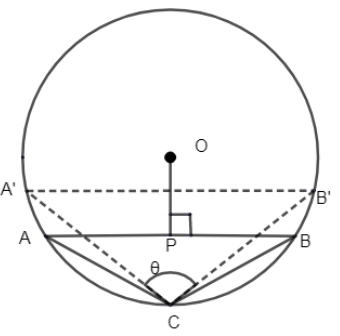
Angle inscribed in a minor segment is
(A). acute
(B). obtuse
(C). right
(D). straight
Answer
513.6k+ views
Hint: To solve this question, we will draw a circle and chords in it (other than diameter) and join the intersection points of the chord and the circumference of the circle to the other points of circumference.
Complete step-by-step solution -
To solve this question, we must first know what is a segment of a circle. A chord of a circle divides the circle into two regions, which are called the segments of the circle. The minor segment is the region bounded by the chord and the minor arc intercepted by chord.

In the above figure,
Option (a): The angle will not be acute because acute angles are less than
Option (b): The angle will be obtuse because obtuse angles are greater than
Option (c): The angle will be greater than
Option (d): The angle can be
Hence, option (b) is correct.
Note: The angle will be
Complete step-by-step solution -
To solve this question, we must first know what is a segment of a circle. A chord of a circle divides the circle into two regions, which are called the segments of the circle. The minor segment is the region bounded by the chord and the minor arc intercepted by chord.

In the above figure,
Option (a): The angle will not be acute because acute angles are less than
Option (b): The angle will be obtuse because obtuse angles are greater than
Option (c): The angle will be greater than
Option (d): The angle can be
Hence, option (b) is correct.
Note: The angle will be
Recently Updated Pages
Master Class 10 General Knowledge: Engaging Questions & Answers for Success

Master Class 10 Computer Science: Engaging Questions & Answers for Success

Master Class 10 Science: Engaging Questions & Answers for Success

Master Class 10 Social Science: Engaging Questions & Answers for Success

Master Class 10 Maths: Engaging Questions & Answers for Success

Master Class 10 English: Engaging Questions & Answers for Success

Trending doubts
A boat goes 24 km upstream and 28 km downstream in class 10 maths CBSE

Why is there a time difference of about 5 hours between class 10 social science CBSE

The British separated Burma Myanmar from India in 1935 class 10 social science CBSE

The Equation xxx + 2 is Satisfied when x is Equal to Class 10 Maths

Chandigarh is the capital of A Punjab B Haryana C Punjab class 10 social science CBSE

Change the following sentences into negative and interrogative class 10 english CBSE




